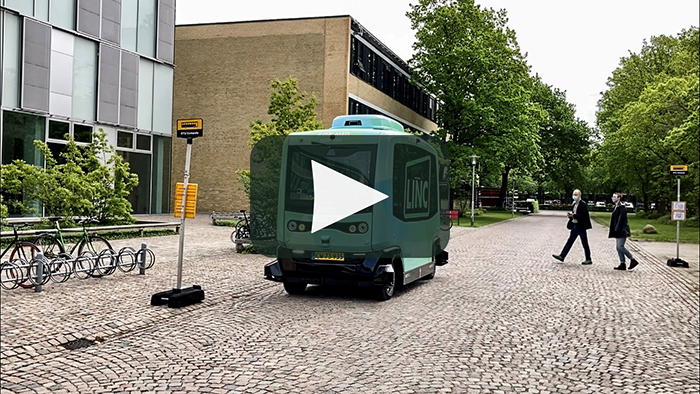Our test drive with the self-driving LINC buses on DTU Campus in Lyngby has been extended throughout the autumn 2021. This opens up the possibility that more students, visitors, and staff can hop on the bus and thus help provide data for the research.
In a few years, students, employees, and guests will be able to change from S-trains to Hovedstadens Letbane at Lyngby Station and be taken to DTU in a few minutes. At DTU, passengers can change to a self-driving shuttle bus and be driven straight to the door on campus.
Right now, three green, self-driving shuttle buses are driving around and collecting passengers on the DTU Campus, while the researchers are collecting knowledge about the passengers' movements in the area. The goal is to find out how driverless transport in the public transport systems can become part of our everyday lives in the future.
Since the beginning of May, the buses have been part of the street scene at DTU through the LINC project, where researchers from DTU Compute, DTU Management, and Roskilde University as well as IBM and a number of other partners are testing the solution. The project is supported by the EU program UIA (Urban Innovative Actions), which has just extended the project so that the test run will continue into the autumn 2021.
This opens up the possibility that more students, visitors, and staff can hop on the bus and thus help provide data for the research.
“Where we originally counted on two test periods of three months at DTU and a test drive in an industrial area in Albertslund, it has been reduced to DTU. At the same time, DTU has been partially shut down due to the Corona pandemic in May and June, and this has reduced the chances of getting passengers to the test trial. We hope that EU’s extension of the project over the autumn will make more people want to drive the buses, so we get more data to work with,” explains Per Bækgaard, associate professor at DTU Compute.
It is free to ride the buses but to help the researchers as much as possible, passengers need to install a LINC app on their phones. The app allows researchers to follow their movement patterns, e.g. whether people only drive in bad weather and how far. At the same time, users will be regularly sent questionnaires, where they must answer questions about the experience and expectations for the driverless transport of the future.
VIDEO: Click on the photo below and see a video (Danish) NOTE: The video link goes to YouTube

Jump and - remember the app
"We hope that the EU’s extension of the project over the autumn will make more people want to drive the buses, so we get more data to work with."
Per Bækgaard, associate professor at the research section Cognitive Systems at DTU Compute.
The latest figures show that approximately 400 people have installed the app. In June, the buses had about 130 different users, and on one of the best days of the special three-week course period in June, the self-driving buses had between 30 and 50 daily users. However, many passengers do not have the app installed.
It is extra important for the LINC project to get useful data at DTU because the test period has been greatly delayed. The app for collecting data was ready in the autumn of 2019, but the approval of the self-driving shuttle buses was complicated, so the buses first hit the streets in May this year.
“We hear from many people that they think the buses are exciting and fun. So there is interest in the project. We just also want more people to install the app and use LINC actively in everyday life on campus for a period of time so that people do not just jump in to try it once. It does not provide such useful knowledge for us,” says Per Bækgaard.
You can meet the LINC buses at DTU Campus in Lyngby during the autumn. Until September, they run at 10 and 15-minute intervals from 6.00 a.m. to 6 p.m.
The roadmap.
- 06:00-12:30 - 10 minute interval
- 12:30-18:00 - 15 minute interval
Road work in connection with the light rail construction may change the timetable.
Per Bækgaard and his colleagues from the research section, Cognitive Systems at DTU Compute have together with other researchers at DTU developed the app that registers the number of passengers and follows people's movement patterns, e.g. do people wait for the bus in rainy weather.
Traditionally, such surveys are conducted by first observing people and then interviewing them 14 days later. The app, on the other hand, collects data in real-time so researchers can see what people are actually doing so they don't have to remember it 14 days later.
Behind the app is a major development and data collection work, which takes place in IBM Cloud. IBM Denmark has in collaboration with DTU developed various functionalities. The app can automatically send out questionnaires, so-called event-triggered surveys - directly to the test passengers in situations where the bus e.g. suddenly stopped.
The app links data from the questionnaires together with data on the test passengers' movement patterns on campus, which is available via GPS and several hundred small Bluetooth beacons placed at the stops, in the shuttle buses, and in buildings near the route at DTU. The many beacons each have a range of approximately 80 meters, and the app, therefore, does not follow the users when they leave the DTU Campus area.